BMTUWTSEP22 Understanding the World of Tourism
Introduction
In this essay, a detailed analysis of the contemporary tourism sector is conducted which will highlight the travel motivations relating to theories for a better understanding of the essay topic selected. Tourism is defined as a social, cultural and economic phenomenon which suggests the movement of people outside the usual environment to pursue recreation, pleasure and relaxation (Amoiradis et al., 2021). On a global scale, tourism is stated to be a highly competitive and dynamic industry which may adapt to the ever-changing behaviour and demands of consumers. According to Grimmer and Vorobjovas, (2020), tourism is defined as the activities which are undertaken by visitors, called the visitors’ economy, which includes a variety of types such as mass tourism, niche and interest tourism both in international and domestic areas. In this essay, the travel motivations in terms of visitors are to be discussed relating to Plog’s, and Maslow’s Hierarchy and the push and pull factors of travel motivations relating to statistical evidence and examples.
Analysis of the development of contemporary tourism
Contemporary Tourism is defined as a new and refreshing dimension of approach in tourism in which the tourists develop an emotional connection in the dimension of travel and engage in real-life experiences with local communities. On a global scale, tourism activity is related to worldwide activities which are no longer barriers geographically, politically, culturally and ideologically bound (Cook et al., 2018). The emergence of globalisation and the social mobility of visitors have laid the opportunity for travellers in venturing into new forms of contemporary tourism including party tourism, cruise ship tourism and nightlife tourism (Gonçalves, and Calisto, 2020). The development of the consumer culture is stated to be one of the essential factors influencing the growth of the tourism industry, relating to three geographical elements including transit route, destination region and generation region (Leiper, 1979). It is identified overcoming the old barriers of travel restrictions due to modern technology and payment options available, the contemporary tourism industry is fast adapting to bringing new experiences (Corbisiero et al., 2022).
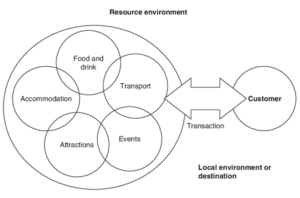
Figure 1: Contemporary tourism
(Source: Corbisiero et al., 2022)
The contemporary tourism sector has focused on the development of a relationship between the destination and the visitors with several modes of transaction, to meet the needs of the consumers providing services of transport, accommodation, attractions and events. In the modern age, environmental resources have become an integral part of modern destination development which has led to increased competitiveness in the industry (Trusova et al., 2020). The contemporary tourism industry has brought new experiences for the millennial generation such as photography tourism, cinema tourism, food tourism, sports tourism and cultural tourism. Furthermore, the impact of the Covid-19 Pandemic has led the global tourism industry to face a huge challenge in attracting tourists as the barriers and restrictions along with safety concerns impacted the economic structure of the nations. However, the emergence of the new concept of the contemporary tourism industry introduced Silver Tourism which has focused on providing aged visitors to avail the tourism experiences (Taloş et al., 2021). It is also identified that the change in consumer behaviour, leading to World Heritage maintains the local needs to be fulfilled along with management of stakeholders’ interests in a sustainable manner (Unesco.org. 2023). Among sustainable tourism, falls is “Ecotourism” which is considered to be a niche segment of tourism offering tourists with travel experiences to engage with nature (Bunghez, 2021).
Critical discussion on motivational theories
Travel Motivation
It is stated that travel motivations are derived through four main motivator’s namely cultural, physical, behaviour, psychological, interpersonal and status or prestige motivators which are related to the travel activities in satisfying the needs of leisure. A travel motivator is defined as the main reason which prompts the travellers to escape, relieve tension, healthy, family togetherness, interpersonal relations, health, sports, environment and adventure (Hinlayagan and Olivar, 2023). On a global scale in 2019, Asia and Pacific and Europe experienced tourism growth by 4% and the USA has led to growth at an exponential rate earning about $8 billion (E-unwto.org. 2023).
Analysing Crompton’s Theory of push and pulls factors of tourism
Travel motivation is stated to be one of the central ideas in gaining an understanding of the reasons behind travelling which are determined by the push and pull factors acting as variables of travel motivation. Crompton’s Theory of Push and Pull factors have identified the pull factors to be the destination characteristics and the push factors to be the traveller’s desire to travel (Pektaş, 2022).
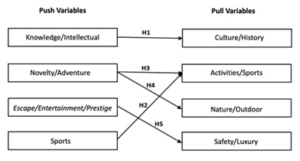
Figure 2: Crompton’s Push and Pull theory of travel motivation
(Source: Pektaş, 2022)
According to Crompton’s Push and Pull Theory, there are identified seven push factors of the traveller’s motivation towards the chosen destination which are escape, prestige, regression, kinship-enhancement, self-exploration, social interaction and relaxation (Crompton, 1979). Additionally, the pull factors are identified as education and novelty, about 57.6% of the total variance termed as infrastructure and facilities relating to “local culture and tradition”, “tourist resources” and exotic atmosphere (Ramseook et al., 2018). A case study, for example, conducted a survey of 150 tourists in Portugal with the travel motivation relating to visiting exotic places is examined with Crompton’s Push and Pull theory (Pereira et al., 2022). About 68.4% of the present total variance has been considered to be push factors labelling towards the travel motivation being accruing knowledge, socialization and leisure. This case study also reveals about 63.5% of the push motives are reliant on the labelled push factors relating to core attractions, landscape features and facilities.
Evaluating Maslow’s Hierarchy related to travel motivation
In gaining a detailed understanding of the motivational factors in terms of travelling, the implementation of Maslow’s Hierarchy of Needs is applied to seek information about human behaviour. According to Maslow’s Hierarchy of Needs, the first set of motives are the psychological needs which are the basic needs met towards travellers’ expected destination with suitable accommodation, restaurants and portable water (Yousaf et al., 2018).
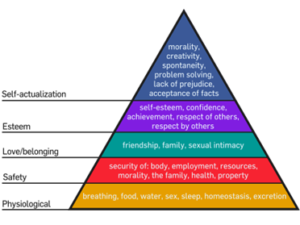
Figure 3: Maslow’s Hierarchy of Needs as Travel Motivation
(Source: Yousaf et al., 2018)
The second need is related to safety-related issues, which is a motivator in increasing the likelihood of a positive response gathered through the sense of protection and safety insurance provided by the destination. The third need is that the theory is forming relationships with people which creates a sense of belonging and confirms the development of healthy relationships. It is stated that among young Backpackers, about 70% of meeting the need for a sense of belonging in the destination relates to the decision to travel in future (Agyeiwaah et al., 2020).
Explaining Plog’s theory relating t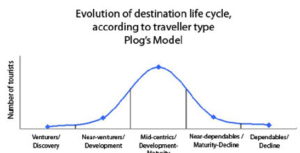 o travel motivation
o travel motivation
According to Plog’s Theory of Psychographic Travel Personally, there may be conceptual connections made using a psychographic framework in which individuals as travellers and the destination of choice may lead to the possible transformation of the chosen destination. According to the theory, allocentric tourists are most likely associated with destination choices and are correlated with the appeal of the destination and lead to the rise and fall of the destination’s popularity. The application of the theory led to Plog in conducting research on 16 domestic and foreign airlines, manufacturers and airframes in 1967 to examine the psychology of segments of travellers (Refer to Appendix 1). According to Bayarsaikhan et al., (2020), Plog has suggested in the theory that destination develops and grows which is related to the attractiveness created towards the different types of travellers.
Figure 4: Plog’s Theory of Psychographic Travel Personally
(Source: Bayarsaikhan et al., 2020)
For example, the types of people, who are most likely to visit destinations which are underdeveloped according to the theory, are stated to enjoy the challenge of travel and are mentally satisfied with the unknown. Plog has also pointed out the destination reaches wide popularity with a well-established image created by the tourists with the intention of future visits. The allocentric tourists who often travel alone are the main segment of consumers for the solo tourism industry and for the cultural tourism industry which is related to the mental excitement leading to choosing destinations.
Conclusion
It may be concluded from this report, that contemporary tourism is a new segment in the tourism industry which is often misunderstood, still has an enormous impact on the global economic level. The change in consumer behaviour and the emergence of technologies and social mobility have led to the development of a new segment in the global tourism industry. It is also stated that the report has identified that destination tourism sectors have brought in varied forms of tourism experiences for the visitors’ needs including nightlife, photography, food, cinema, Silver and eco-tourism cater to the basic needs also. The application of Maslow’s needs theory, Crompton’s Push and Pull theory and Plog’s theory in this report have led to gaining detailed ideas about the psychological insight of visitors determining the destination. Thus, this report highlights that the motivator factors of travel are related to the mental needs of the visitors allowing the tourism industry to bring the best of services.
References
Agyeiwaah, E., Pratt, S., Iaquinto, B.L. and Suntikul, W., 2020. Social identity positively impacts sustainable behaviors of backpackers. Tourism Geographies, pp.1-22.
Amoiradis, C., Velissariou, E. and Stankova, M., 2021. Tourism as a socio-cultural phenomenon: A critical analysis. Journal of Social and Political Sciences, 4(2).
Bayarsaikhan, T., Kim, S.T. and Gim, T.H.T., 2020. International tourists’ destination choice differences according to Plog’s personality types: analyzing the case of Mongolia based on the recreation opportunity spectrum. International Journal of Urban Sciences, 24(4), pp.485-515.
Bunghez, C.L., 2021. The emerging trend of niche tourism: Impact analysis. Journal of Marketing Research and Case Studies, 2021, pp.1-9.
Cook, A., Hsu, C.H. and Taylor, L.L., 2018. The Business of Hospitality and Travel. London: Pearson.
Corbisiero, F., Monaco, S. and Ruspini, E., 2022. Millennials, Generation Z and the Future of Tourism (Vol. 7). Channel View Publications.
Crompton, J.L., 1979. Motivations for pleasure vacation. Annals of tourism research, 6(4), pp.408-424.
E-unwto.org. 2023. International tourism highlights, 2020 edition | world tourism organization (no date). Available at: https://www.e-unwto.org/doi/book/10.18111/9789284422456 (Accessed: February 22, 2023).
Gonçalves, A.C.D.S. and Calisto, M.D.L., 2020. The potential of adjectival tourism for the promotion of a tourism destination (Doctoral dissertation).
Grimmer, L. and Vorobjovas-Pinta, O., 2020. From the sharing economy to the visitor economy: the impact on small retailers. International journal of tourism cities, 6(1), pp.90-98.
Hinlayagan, K.R. and Olivar, K.G., 2023. Socio-Psychological and Cultural Motives of ASEAN Tourist. Archives of Business Research, 11(1).
Leiper, N., 1979. The framework of tourism: Towards a definition of tourism, tourist, and the tourist industry. Annals of tourism research, 6(4), pp.390-407.
Pektaş, F., 2022. Destination as a brand: the impact of push and pull factors of travel motivation on customer-based destination equity. Uluslararası Yönetim İktisat ve İşletme Dergisi, 18(3), pp.856-874.
Pereira, V., Gupta, J.J. and Hussain, S., 2022. Impact of travel motivation on tourist’s attitude toward destination: Evidence of mediating effect of destination image. Journal of Hospitality & Tourism Research, 46(5), pp.946-971.
Ramseook-Munhurrun, P., Naidoo, P., Seebaluck, N.V. and Puttaroo, A., 2018, June. The effects of push and pull travel motivation on tourist experience, tourist satisfaction and loyalty. In Proceedings of the 8th Conference of advances in hospitality and tourism marketing and management (pp. 838-850).
Taloş, A.M., Lequeux-Dincă, A.I., Preda, M., Surugiu, C., Mareci, A. and Vijulie, I., 2021. Silver tourism and recreational activities as possible factors to support active ageing and the resilience of the tourism sector. J. Settl. Spat. Plan, 8, pp.29-48.
Trusova, N.V., Cherniavska, T.A., Pasieka, S.R., Hranovska, V.H., Prystemskyi, O.S. and Demko, V.S., 2020. Innovative clustering of the region in the context of increasing competitive positions of the enterprises of the tourist-recreational destination. Geo Journal of Tourism and Geosites, 31(3), pp.1126-1134.
Unesco.org. 2023. UNESCO World Heritage Centre (no date). Available at: https://whc.unesco.org/uploads/activities/documents/activity-669-7.pdf (Accessed: February 22, 2023).
Yousaf, A., Amin, I. and C Santos, J.A., 2018. Tourist’s motivations to travel: A theoretical perspective on the existing literature. Tourism and hospitality management, 24(1), pp.197-211.
Appendix
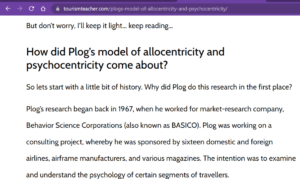
Appendix 1
https://tourismteacher.com/plogs-model-of-allocentricity-and-psychocentricity/
Know more about UniqueSubmission’s other writing services:


I do trust all the ideas youve presented in your post They are really convincing and will definitely work Nonetheless the posts are too short for newbies May just you please lengthen them a bit from next time Thank you for the post